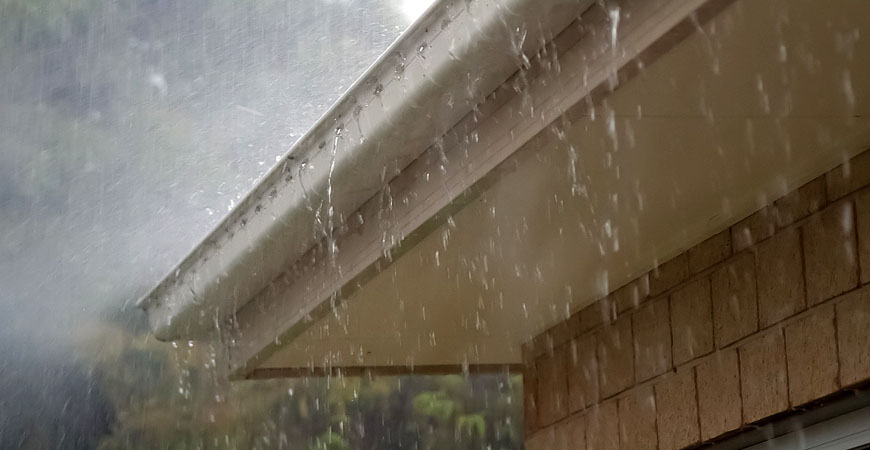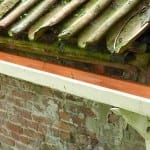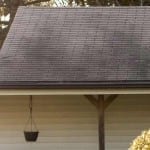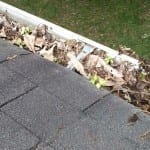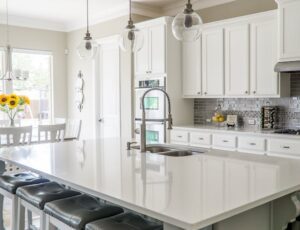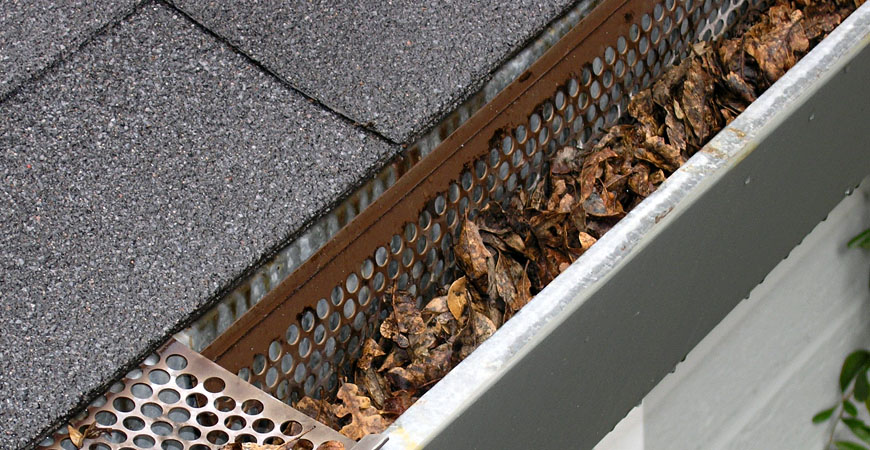
Rain Gutters – How They Work Plus Important Installation Tips
Rain gutters are essential because they protect the exterior of your home. Read on to learn about available gutter drainage options, plus information on proper gutter installation, slope, downspouts, and more.
How do rain gutters work?
Gutters are U-shaped troughs made of metal, vinyl, or copper designed to collect water from your roof. The water moves through the gutter – to the downspout – to the ground and away from your home.
An ordinary gutter channels water along the roofline to a downspout connection and then to the yard – keeping water away from your home’s siding, foundation, windows, and doors.
Why do I need gutters?
Rain gutters are necessary because, without proper drainage, rainwater pouring from the roof or down the side of a house can lead to exterior damage. Over time, water erosion can damage the outside of your home and the surrounding landscaping.
How much do they cost?
According to This Old House, vinyl, coated steel, and aluminum are the least expensive gutter materials. These run from one dollar to eight dollars per linear foot.
Copper and zinc gutters are a bit more pricey – these sell for nine to eighteen dollars per linear foot. (Prices are for materials only.)
Vinyl gutters are easy to install, but they may eventually discolor due to sun exposure – they may also crack in cold climates – something to keep in mind when selecting gutter material.
How do rain gutters attach to the house?
Two types of brackets attach gutters to homes. Fascia brackets attach to your home’s eaves – supporting the gutter from underneath. Downspout brackets secure the downspouts to the side of your home.
Gutter Drainage Options –
Gutters are available in a myriad of sizes and shapes known as ‘profiles’–
Residential gutters come in two sizes – 5-inch and 6-inch–referred to as “K-style.” K-style gutters usually feature a decoratively curved shape, looking similar to crown molding.
A gutter system for a good-sized home consists of 6-inch K-style guttering and 3-inch by 4-inch downspouts.
Half-round gutters are frequently a part of building restorations or historical dwellings. Half-round gutters are “C” shaped, half-round tubes with a decorative, curved front. Box and square line profiles are also available.
Open gutters are the most common type. Open gutters are available in standard lengths, making installation easy for DIYers. They are also available in seamless roll-form and best for a professional to install.
The fewer the seams, the fewer water leaks.
Learn more about the different gutter options here.
An Overview of Gutter Materials –
Seamless Aluminum – Seamless (sometimes called continuous) aluminum gutters are made on-site by a gutter installation professional. A spool of flat aluminum is fed into a gutter-forming machine. The machine then custom cuts the material to the necessary length.
Most professional installations are seamless as it minimizes leakage.
Aluminum – Aluminum is the most common type of gutter material. It’s lightweight and easy to install – perfect for DIYers. They are available in a wide range of colors. Bonus – it won’t rust.
Vinyl – Ideal for the do-it-yourselfer, vinyl is lightweight and inexpensive – the vinyl sections clip together during installation. However, there aren’t many options available for color choices.
Keep in mind that vinyl guttering cannot support the weight of a ladder. This makes them more challenging to clean.
Copper – Beautiful but pricey, copper gutters are typically a part of building restorations or high-end homes—the bright copper color weathers to a green verdigris patina over time. Hiring a professional is necessary if you want copper gutters around your home as they require welding at the joints and seams. Advantage – copper gutters don’t rust.
Steel – Galvanized steel is sturdy and resists rust for years. Usually heavy and sometimes expensive, steel gutter installation should be done by the pros. Advantages – Steel is available in many color options and is safe to paint.
Zinc – Like copper, zinc will take on a rich patina over time. Zinc is expensive, long-lasting, and stands up to the weather. It is also often used for historic home restoration. Zinc gutters require welding, so it is necessary to hire a pro.
Installation Tips for DIYers –
Tips for Estimating Component Quantities –
Gutters and downspouts – Measure the length of the existing gutters and downspouts. For new guttering, measure the circumference of your home at ground level and your home’s height.
Waste and trim – Buy 10% more materials than you think you’ll need. (Gutters are sold in standard lengths so that some cutting will be required.)
Clips – Check the manufacturer’s recommendation for the number of clips needed per gutter length. A general rule is
- Metal gutters – one clip per 2-yard length
- Vinyl gutters – one clip per 1-yard length
Union Brackets – For jointed gutters, figure the number of joints. You’ll need one union bracket per joint.
How many downspouts will I need?
The number of downspouts you’ll need varies depending on –
- Your gutter system’s capacity
- The best exterior location where a downspout can direct water away from your home
Some detailed figuring may be required for new gutter installations. A rough estimate – install one downspout for every 30-40 feet of gutter.
Downspouts are available in round or rectangular shapes. Add extra downspouts to boost system capacity. The most common shape is rectangular, in sizes –
- 2-inch by 3-inch, and
- 3-inch by 4 inch
Each downspout will need a splash block. A splash block is at the end of the downspout to move water away from your foundation.
How do I figure the slope?
You’ll need to attach the gutters at a slight downward angle so the water will flow to the downspouts. Gutters should slope downward 1/4-inch per 5-feet length of gutter. Mark your fascia board with the beginning and end points – snap a chalk line to use as a reference.
What thickness (gauge) should I buy?
It depends on where you live. Standard thicknesses are .027 and .032. A heavier gauge (.032) is necessary for durability in snowy northern climates. For copper gutters, professionals recommend a 0.32 thickness. Remember, the thicker the material, the longer it will last.
Can I paint my aluminum gutters?
Painting aluminum gutters is not recommended because –
- If your gutters come with a paint finish warranty, painting them may void the warranty
- Paint applied to factory-painted gutters will eventually peel and chip.
Without proper drainage, rainwater falling from the roof can cause problems on the home’s exterior, foundation, and surrounding landscape. The gutter drainage options and tips above will help you choose the best guttering solution for your home.
Click here to learn how to keep your rain gutters clean.

